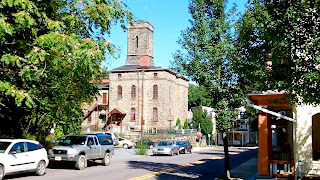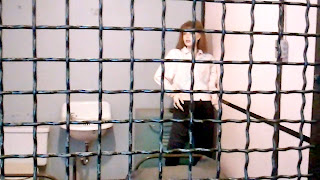As I entered the waiting room and looked around I saw the sign on a mantle.
"I guess my wife's out of luck," I said to another man sitting nearby.
"Uh?" he said and I jerked my thumb to the old notice.
My wife is Irish; well, part Irish anyway. She had an Irish maiden name. Her other main parts are German and Native American (one-quarter Creek).
T'is, me Lads, the irony that Mauch Chunk should end up named Jim Thorpe. It is also an example of how this country can and does change usually in the right ways. You see, Jim Thorpe had a part-Irish, part-Sac and Fox father, one Hiram Thorpe. Jim's mother, Charlotte Vieux had a French dad and Potawatomi mom. Hiram and Charlotte named their son Wa-Tho-Huk ("path lighted by great flash of lightning") and raised him as a Sac and Fox. He was also Roman Catholic, which was probably another strike against him in some places in those times.
Jim Thorpe was born in 1888. Eleven years earlier there was an incident in Mauch Chuck that shows he probably wouldn't have been welcome there in 1877, even possibly the decade-plus later when he was born in Oklahoma. He probably would have been shunned or worse for being (1.) Irish, (2.) an "Injun" and (3.) a papist.

To illustrate some of the mind-set of those times I will take us back to those mansions on top of the hill, specifically the home of Asa Packer. I mentioned therein that the Packers, rich as they were, but people of hard-working humble beginnings, existed in wealth a long while without the prerequisite servants, until Sarah Packer reached a point when doing it all herself was difficult. They hired a Butler and a Maid, who each had separate quarters in the house. The Packers, faithful to their Protestant morals wanted to be sure there was no hanky-panky between this single man and single woman. Thus they hired an Irish Catholic Butler and a German Lutheran Maid, knowing one would never have anything to do with the other. (This is another story with ties to The Little Woman, with her Irish father and German mother, and being raised a Lutheran.)
If that is an amusing story, there are many darker tales to tell of the prejudices of those times, especially against the Irish.
The Irish lot on their native sod was not a particularly happy one in the 19th Century. They were viewed as less than vermin by England, to which they were subject much against their will. Many lived in abject poverty; in fact, it was rare if an Irish family was able to serve one piece of meat a year in their meals. Beginning in the 1840s many Irish began to immigrate to the United States and this flow continued well into the 1880s. The English took a "good riddance to rubbish" attitude and encouraged this.
The United States also encouraged this influx of Irish, at least the industrialist of the day did. They saw these people as an underclass, a supply of cheap labor and a desperate people they could exploit. They were not welcome in every place of business, as the sign at the beginning of this post shows, but they were welcomed into the black holes of Pennsylvania and West Virginia where coal could be harvested.
Mauch Chunk was a coal town.
Working as a coal miner was far from paradise, not only might you be digging down toward Hell, your life was the Devil's own as well, barely a notch about slavery. You worked a long day on a dangerous job for very little pay. Worse yet, you owed everything to the company. You lived in homes provided by the company, so leaving your job was forfeiting the roof over your head. You had to buy your own work tools and supplies from the company, which you could get at the company store, where you also bought the other necessities of your life. You got credit on your purchases, so to speak, but then your bill was deducted from your wages on payday. It wasn't unusual for a miner to find he owed more than his pay and so go home with nothing in this pocket.

During the time of this miserable situation grew a secret organization known as The Molly Maguires. How secret were they? So much so historians really know very little about them. Were they the terrorist one owner painted them to be in their day, killing brutally and often? Were they a discredited and maligned group of fighters for labor reformation? Truth is they were probably somewhere in between, but they had enough influence that owners of the coal industry saw them as a threat to the status quo and of course blamed every dirty deed that came down the pike on them.
One such industrialist was Franklin B. Gowen (pictured left). Like Asa Packer, Gowen was a wealthy, powerful man in Pennsylvania. He was the president of the Philadelphia Coal and Iron Company and the director of the Philadelphia and Reading Railroad. He was also a former Attorney General.
To say he was anti-union is an understatement and he did everything in his power to destroy any progress by labor that might effect his business. He made this statement about the words of the Declaration of Independence, "All men are created equal":
“Men were not created equal, the distinction between mind and matter, between the men who labored with
their heads and those who labored with their hands. There [are] two great classes of people in this world, men of genius, or intellectual men, and those who [are] not so, the
men of labor."
Anyway, to make a long and fascinating story short, Gowen came to blame the Molly Maguires for all things Union and hired the Pinkerton Detective Agency to bring the group down. Eventually several men were arrested and charged with murder on the word of one detective, James McParlan, who went undercover and acted as an informant. He began accusing Molly Maguires after a murder where he had a hand in and may have been responsible for.
Four men were brought to trial at the Old Jail of Carbon County in the town of Mauch Chunk upon the lone testimony of McParlan. This was not a criminal trial, but a private one in which the county simply supplies the facilities. The Judges were men connected to Gowen and there is the possibilities he rigged the jury. In 1877 four men, accused of being Molly Maguires and murderers were hung inside the Old Jail on gallows brought in for the occasion. They were John Donahue, Edward Kelly, Michael Doyle and Alexander Campbell.
Campbell left an impression behind. Declaring his innocence, he rubbed his hand on the floor and pressed his handprint into the wall of his cell. This was 137 years ago, but the handprint is still there for all to see (I saw it myself). Attempts were made to remove the print, but all failed. Here is the history of the handprint as described at Paranormal@101:
Over the years, county sheriffs have tried to remove the
handprint to no avail.
In 1930, Sheriff Biegler had the wall torn down and
replaced. The next day, the handprint reappeared.
Around thirty years later, Sheriff Charles Neast covered
the handprint with latex paint, but it reappeared. His son, Tom, in the 1960s,
loved to tell friends about the ghostly phenomenon. Word spread and people
visited the Carbon County Jail to see the print.
Attempts to wash the image away failed.
In recent years, James Starrs, George Washington
University forensic scientist, and Jeff Kercheval, Hagerstown MD police
chemist, analyzed the handprint using high tech equipment. They found no
logical scientific explanation for the handprint’s existence. They finally
measured the exact location of the image in the event it there were attempts to
remove it and it reappeared, they would know if the phenomenon returned to the
same location or a different one.
The jail’s last sheriff, Bill Juracka, said he wouldn’t
try to remove the handprint.
Now a days you can tour the Old Jail in Jim Thorpe. It is fascinating and a bit spooky. You enter and get your tickets and then go to the waiting room to await your guide. This area was actually the home of the Warden and his family, so in a sense the Warden was in jail with his prisoners. In fact, when you go upstairs you are brought through the Warden's family bathroom and into a side wing of the jail where women offenders were housed.
From there you wend your way back down into the main cell block where the men were. Here you see the infamous gallows that hung the Molly Maguires and Cell #17, where Campbell's handprint can be viewed upon the wall. (Sorry, they would not allow photographs of the handprint. Now, to tell the truth, it would have been very easy to sneak a picture, especially with my Flip, but I chose not to do that. The photograph seen above is from Weird Pennsylvania.)
To say the interior of the jail is bleak is an understatement. It would not be a place I would ever wish to find myself. That in itself should encourage one to behave. More depressing were the dungeons in the basement. Visiting these isolation cells certainly gave more meaning to the old coal miner's song:
It's dark as a dungeon and damp as the dew
Where the danger is double and pleasures are few
Where the rain never falls the sun never shines
It's a dark as a dungeon way down in the mine.
I don't want to tell some of the stories I heard there because if possible I think you should go and enjoy the tour. One of the amazing things to me is this jail was in service until 1995. I will leave you with a few more photos of the place, including our charming young guide holding up the narrow window through which a prisoner once escapes.

Although this prisoner was only sentenced to about a third of a year, he determined to break out. His method was probably worse than his punishment. First he starved himself until he felt he had lost enough weight to squeeze through the window frame the guide is holding up. meanwhile he stole the soap from the shower room until he had a supply hidden away. On the day of his escapade, he striped naked and lathered up his whole body. With help from his cell mates he pushed this window frame out on its pivot. He tossed his clothes down in a pillow case and flung tied together sheets out to climb down upon. Believe it or not, he got through that window and probably would have been far away, except he attempted his escape at 12 noon. Some women eating lunch on their porch were surprised seeing a foamed up naked man shimmying down the jail wall and...well, he was soon caught.

A word about Franklin Gowen, the head of the Philadelphia and Reading railroad. Said Mr. Gowen was found dead in a Washington DC hotel room on December 19, 1889, a small caliber pistol by him and powder burns on his face. His hotel room was locked and his death at age 53 was ruled a suicide. Stories and speculation arose that he had been murdered, and it was claimed this was done by a Molly Maguire who actually looked like Gowen. It was said this assassin had stalked him for years, had even purchased the pistol using Gowen's name and had hid in the hotel room, did the deed and escaped out the window.

People questioned his taking his own life because he was still relatively young, had wealth, reputation and a family. They saw no reason to think he would do such a thing, so it had to be murder and who better to blame than the Molly Maguires. However, I lean toward it being suicide. Gowen was no longer the head of the railroad. In fact, he was seeing a number of bonds he was involved with declining in value at this time and it might have been more a financial concern that led to his self-elimination.
All photos inside and out of the Old Jail by the author except:
The portrait of Franklin Gowen
The Jim Thorpe Wheaties Box
The Campbell Handprint in Cell 17 is from
Weird Pennsylvania.





















































